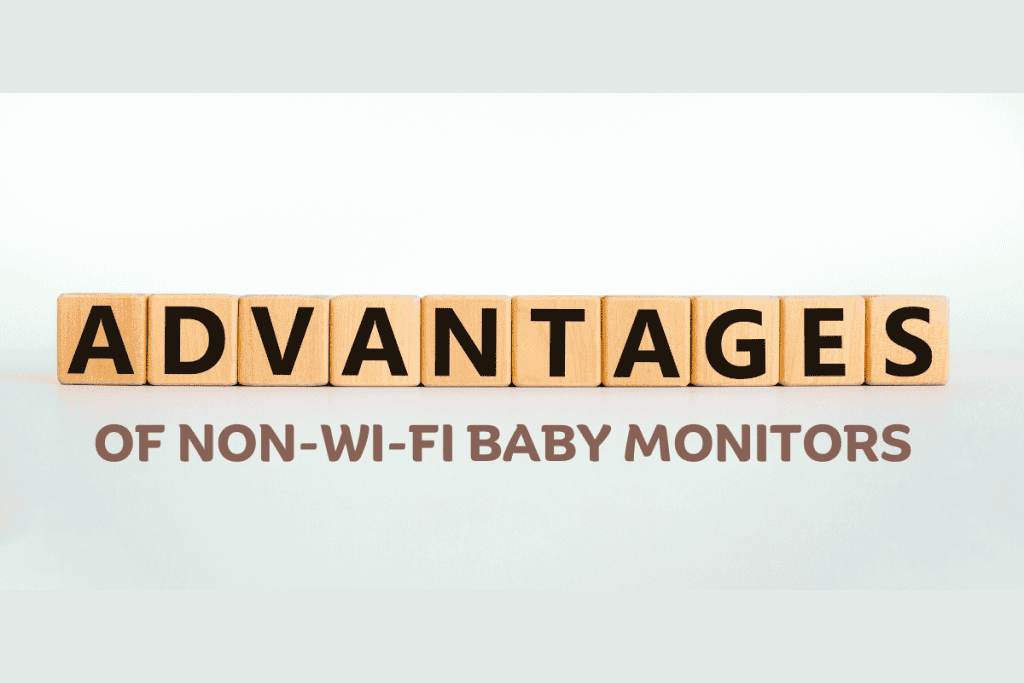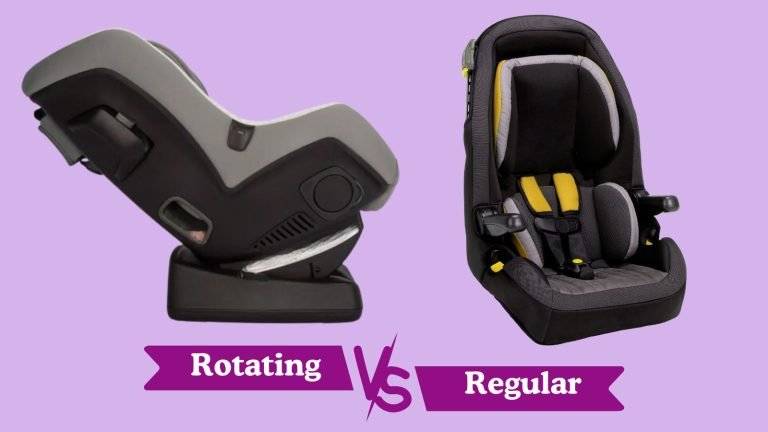Non-WiFi vs WiFi Baby Monitors: Navigating 10 Essential Pros and Cons

In parenting, your baby’s first words may be ‘Wi-Fi’ or ‘No Wi-Fi,’ depending on the type of baby monitor you choose. This guide will help you navigate the somewhat confusing world of non-WiFi versus Wi-Fi baby monitors.
You’ll discover the pros and cons of each, from the reliability of Non-WiFi Baby Monitors to the convenience alert features of Wi-Fi ones.
By the end, you’ll have all the information you need to choose the best option for your little one’s safety and peace of mind. So, let’s dive in and find your perfect baby monitor fit.
Key Takeaways – Non-WiFi vs WiFi Baby Monitors
- Non-Wifi baby monitors have reduced interference and are more secure from hacking.
- Wi-Fi baby monitors provide ease of access for parents and advanced analytics tools.
- Non-Wifi baby monitors have limited features and range of operation.
- Wi-Fi baby monitors depend on the home Wi-Fi signal range and have privacy and security concerns.
Understanding Baby Monitors: A Primer

There’s a wide variety of baby monitors available, each offering unique features desired to keep you connected with your baby. Whether you prefer simpler models or more advanced technology, you’ll find a monitor that suits your lifestyle and meets your baby’s needs perfectly.
How Non-WiFi Baby Monitor Works is an important factor to consider when choosing between options. Digital monitors offer clear sound, higher video quality, and improved privacy. However, they’re pricier and may have a limited range.
Then there are audio-only monitors, which let you hear your baby’s sounds. They’re budget-friendly but might leave you guessing what’s happening during the baby’s sleep in the child or baby’s room or the nursery.
Video monitors offer video and audio, giving you a clearer picture of your baby. However, they can be pricey, and sometimes the image quality isn’t the best.
WiFi-enabled monitors let you check in on your baby from anywhere using your home network or a smartphone app. They offer great convenience but also come with security concerns.
Your decision will be influenced by what fits your budget, matches your needs, and feels comfortable given your familiarity with technology. Remember to consider sound quality, video clarity, and privacy when deciding.
Advantages of Non-Wifi Baby Monitors

Choosing non-Wi-Fi baby monitors comes with several advantages. They tend to be simpler to use and provide a more stable connection in areas where the home’s Wi-Fi signal is weak or unreliable.
- Interference Issues: Non-WiFi baby monitors use a distinct frequency from most household electronics, which greatly minimizes the risk of interference. This means you’re less likely to experience hiccups in the Monitor’s signal, ensuring consistent vigilance over your baby’s activities.
- Non-WiFi monitors also offer a more secure connection, as they’re not susceptible to hacking via the internet.
- Battery Life: Non-WiFi monitors consume less power than their Wi-Fi counterparts, extending their battery life. This longer battery life can be particularly beneficial during power outages or when you’re away from a power source.
While these benefits make non-WiFi monitors appealing, they do have some limitations.
It’s important to balance these advantages with potential downsides to make a well-informed choice. Next, we’ll explore the disadvantages of non-WiFi baby monitors.
Drawbacks of Non-Wifi Baby Monitors

Despite their advantages, non-WiFi baby monitors have limitations that can affect monitoring efficiency. One significant downside is the possibility of encountering interference problems.
Non-WiFi baby monitors operate on a particular frequency band, which can get crowded with other devices such as cordless phones, microwaves, and Bluetooth gadgets. This congestion often leads to signal disruptions, affecting the monitor’s reliability.
Interference from other devices can cause static, buzzing, or even sound loss, making it challenging to keep track of your baby’s activities and well-being. Additionally, non-WiFi baby monitors often have a limited range, which can further hinder their effectiveness.
Unlike WiFi baby monitors, which let you check in on your little one from anywhere with an internet connection, non-WiFi monitors have a limited range within which they can operate effectively.
If you move beyond this range, the connection to your monitor will weaken or drop entirely. This can limit your mobility around the house or yard, restricting your activities while your baby is sleeping or crying.
Understanding these limitations is essential for selecting the monitor that best meets your requirements.
Benefits of Wi-Fi Baby Monitors

While it’s natural to be cautious about potential flaws, it’s important to recognize the significant benefits that come with using a Wi-Fi baby monitor.
The advantages of a Wi-Fi baby monitor are manifold; two standout points are remote accessibility and advanced analytics.
- Remote AccessibilityWi-Fi baby monitors offer the ability to check in on your little one from virtually anywhere. You can access the Monitor’s feed on your smartphone or tablet with an internet connection. This feature is especially useful when you’re not at home but still want to closely monitor your baby.
- Advanced AnalyticsMost Wi-Fi baby monitors come with sophisticated analytics tools. They can track your baby’s sleep patterns, breathing rates, and movement. This data can be invaluable for understanding and improving your baby’s sleep quality.
Wi-Fi monitors aren’t just about watching your baby’s crib alone; they’re about better understanding your baby’s needs and being there for them, even when you physically can’t.
But, like any other technological tool for modern parents, they aren’t without limitations. Let’s now explore the ‘limitations of Wi-Fi baby monitors.’
Limitations of Wi-Fi Baby Monitors

Even with all their impressive features, Wi-Fi baby monitors have some restrictions you should know. Let’s delve into a few of these limitations.
Signal Interference
- Wi-Fi baby monitors rely on your home’s Wi-Fi signal.
- The Monitor’s functionality is affected if the signal is weak or drops completely.
- This can leave you without the ability to check on your baby remotely, potentially causing anxiety.
Parental Controls
- Many Wi-Fi monitors have robust parental controls, but hacking is risky, especially if your network isn’t secure.
- This compromises the privacy of your baby and your home, a concern for many parents.
Dependence on Electricity
- Wi-Fi monitors need a constant power supply.
- During power outages, they become useless, leaving you unable to monitor your baby during critical times.
Despite these drawbacks, it is important to weigh them against the benefits of Wi-Fi monitors. Despite these drawbacks, it is important to weigh them against the benefits of Wi-Fi monitors. Are the advanced features worth the potential limitations?
Consider your specific needs as we transition into the subsequent section about ‘making your decision: non-wifi vs. Wi-Fi monitors.’
Making Your Decision: Non-Wifi Vs. Wi-Fi Monitors

Choosing between Non-WiFi and Wi-Fi baby monitors involves carefully evaluating their features, particularly security considerations.
It’s essential to consider both the benefits and drawbacks of each type of baby monitor. Factors like video and audio clarity, the monitoring range, and the reliability of internet connections for two-way audio are critical.
Moreover, it is essential to not disregard any possible safety issues. Security breaches could risk your family’s privacy, so opting for a monitor with strong security measures is vital.
Comparing Monitor Features
You’ll find that non-Wifi and Wi-Fi baby monitors have unique features to help you make an informed decision.
Two of the most important aspects to consider when comparing features are monitor durability and battery life.
Monitor Durability
- Non-Wifi Monitors: Typically more durable due to less complicated technology.
- Wi-Fi Monitors: Could be more susceptible to damage; quality varies by brand.
Battery Life
- Non-Wifi Monitors: They often have longer battery life as they don’t constantly send data over Wi-Fi.
- Wi-Fi Monitors: Battery life can be shorter due to continuous data transmission.
Deciding between non-Wi-Fi and Wi-Fi monitors boils down to evaluating their features based on your individual needs and preferences.
Security Concerns Addressed
When choosing between non-Wifi and Wi-Fi baby monitors, one critical aspect you can’t overlook is the level of security each option offers. You need to consider encryption methods and privacy policies.
Non-Wifi Monitors
- Use analog signals, less prone to hacking
- No privacy policies, and data is not collected.
- Limited encryption, the potential for interference
- No internet connection is needed, and they’re less vulnerability
Wi-Fi Monitors
- Use digital signals, more prone to hacking
- Privacy policies vary, and data may be collected
- Strong encryption, better data protection
- Internet connection required, more vulnerability
Non-Wifi monitors tend to be less vulnerable to hacking due to their lack of a constant internet connection and limited encryption.
On the other hand, Wi-Fi monitors typically have stronger encryption, but their need for an internet connection can make them
Summary
Choosing between non-WiFi and Wi-Fi baby monitors ultimately depends on your needs and priorities.
Non-WiFi traditional baby monitors offer security and simplicity, while Wi-Fi monitors provide convenience and advanced features.
It’s essential to weigh the pros and cons carefully, considering your home’s setup, tech-savvy level, and comfort with privacy issues. Remember, the best baby monitor gives you peace of mind and suits your lifestyle.
Frequently Asked Questions
How Does the Cost of Non-Wifi Baby Monitors Compare to Wi-Fi Baby Monitors?
Generally, non-Wifi baby monitors are less expensive than Wi-Fi ones. However, you’ll need to consider other factors like monitoring durability and product warranties to determine the best fit for your budget and needs.
Can Non-Wifi Baby Monitors Be Used in Areas With Poor or No Internet Connection?
You can use non-Wi-Fi baby monitors in areas with poor or no stable internet connection. They rely on signal strength and range, not the wireless internet connection, and maintaining a constant Wi-Fi connection doesn’t drain their battery lifespan.
Are Any Health Risks Associated With the Prolonged Use of Wi-Fi Baby Monitors?
Yes, there’s potential for health risks with Wi-Fi technology and baby monitors. They emit electromagnetic emissions, which some studies suggest could cause sleep disturbances.
However, more research is needed to fully understand the long-term effects of Wi-Fi monitor technology and baby monitors.
Can Wi-Fi Baby Monitors Be Hacked, and How Can I Prevent This?
Yes, Wi-Fi baby monitors can be hacked. You can prevent this by implementing encryption measures and firewall protection. It’s crucial to update your passwords and software regularly for optimal security.
Can I Use Both Non-Wifi and Wi-Fi Baby Monitors Simultaneously for Added Security?
Yes, you can use both non-Wifi and Wi-Fi baby monitors simultaneously. However, potential signal interference and the combined drain on battery lifespan should be considered. Evaluate your specific needs to ensure this dual setup suits you.





